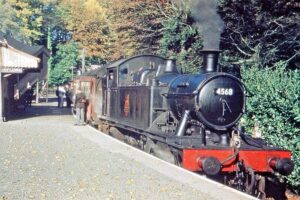Case for Reopening the Princetown Railway
Page Index
Introduction
Historical and Cultural Significance
Boost to Local and Tourism Economy
Environmentally Friendly Access to Dartmoor
Revitalising Public Interest in Heritage Railways
Scenic and Unique Travel Experience
Potential for Seasonal and Special Event Services
Leveraging Existing Infrastructure and Track bed Preservation
Proposed Business Plan
Conclusion
Introduction

Reopening the Princetown Railway offers a unique chance to bridge past and present by blending historical preservation with eco-tourism. This plan outlines how a revived railway could bring Dartmoor’s history to life, attract new visitors, and boost the local economy, all while preserving an iconic heritage line.
1. Historical and Cultural Significance
The Princetown Railway dates back to the early 1800s, originally created to support local industries and transport supplies to the prison. As a historical landmark, it stands as a testament to early engineering and rural development in Devon. By reopening the railway, visitors would gain insight into the moorland past and its role in shaping the community and the moorland culture.
The reopening could also include a dedicated museum or educational centre, with exhibits on railway history, Dartmoor geology and the railway’s impact on local life. Such a centre would foster deeper appreciation and attract educational tourism.
2. Boost to Local and Tourism Economy
The Princetown Railway could become a significant economic driver for the region. Heritage railways are proven to attract both domestic and international visitors, especially when offering a unique experience like Dartmoor’s high-altitude route. A revived railway would not only draw more visitors but provide a stable revenue stream for local businesses, such as hotels, restaurants, and shops.
Collaborative marketing with local tourism boards, a user-friendly website for ticket bookings and strategic partnerships with nearby attractions could further enhance the railway’s economic impact. Ticket promotions with regional events and accommodation packages would encourage longer stays in the area.
3. Environmentally Friendly Access to Dartmoor
Offering an eco-friendly alternative to car travel, the Princetown Railway would reduce road traffic on Dartmoor, helping preserve the region’s natural beauty. Many popular destinations experience degradation due to high levels of vehicle traffic and providing a railway option could help mitigate this impact to the moor. Dartmoor’s delicate ecosystem, known for its rare flora and fauna, would benefit significantly from this reduced footprint. The railway could adopt eco-friendly practices, such as using energy-efficient locomotives, further aligning with sustainable tourism practices.
4. Revitalising Public Interest in Heritage Railways
As public interest in heritage preservation grows, the Princetown Railway would resonate with audiences who value historical preservation. Through guided tours, period re-enactments and vintage train rides, visitors could engage with a piece of living history. Partnerships with heritage organisations and universities could further enrich this aspect by offering workshops, heritage seminars and collaborative events.
5. Scenic and Unique Travel Experience
Traversing through Dartmoor’s tors and moorland landscapes, the Princetown Railway would provide a travel experience unique to Devon and England as a whole. The journey to the highest railway station in England offers panoramic views and a rare opportunity to experience the rugged beauty of the moors from the comfort of a historic train.
6. Potential for Seasonal and Special Event Services
Special event trains could add to the railway’s appeal, attracting more visitors and generating additional revenue. Themed events could include winter holiday rides, historical re-enactments, heritage festivals and photography tours.
Partnering with local businesses to sponsor or collaborate on events could enhance the offering. For example, a local brewery might sponsor an “Ale Train” featuring local craft beers, or a nearby farm could host “Autumn Harvest” rides. These events would not only diversify revenue streams but also encourage repeat visits.
7. Leveraging Existing Infrastructure and Track bed Preservation
Much of the Princetown track bed remains intact, offering a cost-effective opportunity to restore the railway with minimal environmental impact. Restoring the original route would maintain historical accuracy, while modernising certain elements could enhance operational efficiency.
8. Proposed Business Plan
A. Market Analysis
Key demographics for the railway include families, history enthusiasts, railway aficionados, nature lovers, and school groups. A major marketing focus would be on heritage tourism, capitalising on the growing interest in historical and eco-tourism experiences.
By collaborating with Dartmoor National Park, Visit Devon and heritage travel platforms, the railway could reach a broad audience. Social media, a dedicated website with online booking and partnerships with travel influencers and local tourism agencies would strengthen the outreach.
B. Revenue Streams
- Ticket Sales: Standard, return, family passes, and premium ticket options, even first-class and observation car seating.
- Event Tickets: Seasonal and themed events such as holiday rides, heritage days, and photography tours could attract diverse audiences.
- Merchandise Sales: Branded products, such as apparel, souvenirs and replica tickets, could be sold at stations and online.
- Concessions and Dining: Onboard dining cars or station cafés, offering local specialties, would enhance the visitor experience.
- Educational Tours: Schools and universities could book educational trips, with potential revenue from curriculum-aligned tours and historical workshops.
- Sponsorships and Donations: A “Friends of Princetown Railway” membership programme, along with donation boxes and sponsor opportunities, could support operational costs.
C. Funding and Investment Sources
- Heritage Lottery Funding: Grants for heritage preservation projects, specifically geared towards railways and historical sites.
- Local and Regional Economic Grants: Economic development funds focused on tourism and rural areas.
- Community Investment: Crowdfunding campaigns to gather public support and contributions from enthusiasts.
- Private Investors and Sponsors: Partnerships with local businesses and brands interested in promoting sustainable tourism and community heritage.
D. Operational Plan
The railway would operate on a seasonal schedule with increased service during peak tourist months. Volunteer programmes would help staff stations and train operations during busy periods, reducing labour costs and building community support.
Maintenance and safety checks would be performed regularly, with major work scheduled during the winter months to ensure minimal disruption. Partnerships with local educational institutions could provide interns or apprentices for hands-on training in railway operations, reducing maintenance costs.
E. Marketing and Promotion
The marketing strategy would focus on digital outreach, including social media campaigns, travel website listings and local tourism board collaborations. Seasonal events and discounts could be promoted through email marketing, social media, and regional travel publications. The brand would emphasise sustainability, heritage preservation, and unique travel experiences to attract eco-conscious and heritage focused tourists.
Conclusion
 Reopening the Princetown Railway offers a chance to revitalise a historical landmark, promote sustainable tourism and provide economic benefits to the local community. With the right funding, a clear business plan, and targeted marketing, this heritage railway could flourish, providing a unique way for visitors to connect with the history and beauty of Dartmoor.
Reopening the Princetown Railway offers a chance to revitalise a historical landmark, promote sustainable tourism and provide economic benefits to the local community. With the right funding, a clear business plan, and targeted marketing, this heritage railway could flourish, providing a unique way for visitors to connect with the history and beauty of Dartmoor.
Your thoughts and comments are welcome here.
read about the history of The Princetown Railway (1883 – 1956) here
